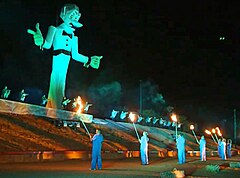
Taos is a town in Taos County in the north-central region of New Mexico in the Sangre de Cristo Mountains. Initially founded in 1615, it was intermittently occupied until its formal establishment in 1795 by Nuevo México Governor Fernando Chacón to act as fortified plaza and trading outpost for the neighboring Native American Taos Pueblo and Hispano communities, including Ranchos de Taos, Cañon, Taos Canyon, Ranchitos, El Prado, and Arroyo Seco. The town was incorporated in 1934. As of the 2010 census, its population was 5,716.

Santa Fe de Nuevo México was a province of the Spanish Empire and New Spain, and later a territory of independent Mexico. The first capital was San Juan de los Caballeros from 1598 until 1610, and from 1610 onward the capital was La Villa Real de la Santa Fe de San Francisco de Asís.

Zozobra is a giant marionette effigy constructed of wood, wire and cotton cloth that is built and burned on the Friday of Labor Day weekend prior to the annual Fiestas de Santa Fe in Santa Fe, New Mexico, United States. It stands 50 ft. 6 in. high.

Santa Cruz, historically known as Santa Cruz de la Cañada, is a census-designated place (CDP) in Santa Fe County, New Mexico, United States. It is part of the Santa Fe, New Mexico Metropolitan Statistical Area. The population was 423 at the 2000 census.
The Pueblo Revolt of 1680, also known as Popé's Rebellion or Popay's Rebellion, was an uprising of most of the indigenous Pueblo people against the Spanish colonizers in the province of Santa Fe de Nuevo México, larger than present-day New Mexico. The Pueblo Revolt killed 400 Spaniards and drove the remaining 2,000 settlers out of the province. The Spaniards reconquered New Mexico twelve years later.
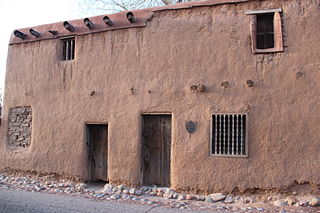
The De Vargas Street House, often referred to as the Oldest House, is a historic building in Santa Fe, New Mexico, which is often said to be one of the oldest buildings in United States. The original date of construction is unknown but the majority of the building is believed to date to the Spanish colonial period (post-1610). One archaeological study also concluded that some sections of the walls are characteristic of Pueblo architecture and may be pre-Spanish in origin. The building was listed on the National Register of Historic Places and New Mexico State Register of Cultural Properties in 1968 as a contributing property in the Barrio De Analco Historic District.

Old Town is the historic original town site of Albuquerque, New Mexico, for the provincial kingdom of Santa Fe de Nuevo México, established in 1706 by New Mexico governor Francisco Cuervo y Valdés. It is listed on the New Mexico State Register of Cultural Properties as the Old Albuquerque Historic District, and is protected by a special historic zoning designation by the city. However, prior to its establishment as a city in the Santa Fe de Nuevo México province, many indigenous tribes lived there including Diné, Pueblo, Apache, Tiwa, and others. The present-day district contains about ten blocks of historic adobe buildings surrounding Old Town Plaza. On the plaza's north side stands San Felipe de Neri Church, a Spanish colonial church constructed in 1793.

The Palace of the Governors is an adobe structure built in the Territorial Style of Pueblo architecture on Palace Avenue in Santa Fe, New Mexico. Located within the Santa Fe Historic District along the Santa Fe Plaza between Lincoln and Washington avenues, it served as the seat of government for New Mexico for centuries, having been established as the capitol building of Nuevo México in 1610. It was New Mexico's seat of government until 1901.
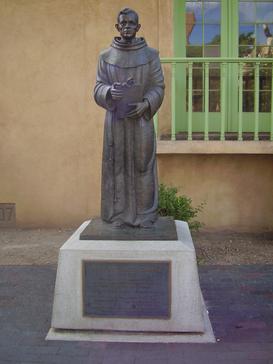
Angelico Chavez, O.F.M., was an Hispanic American Friar Minor, priest, historian, author, poet and painter. "Angelico" was his pen name; he also dropped the accent marks from this name.

Taos Plaza is a center of shops and monuments within the Taos Downtown Historic District in Taos, New Mexico.
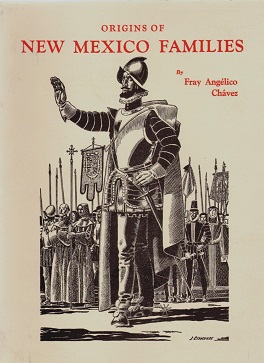
Origins of New Mexico Families: A Genealogy of the Spanish Colonial Period by Fray Angélico Chávez is an important work on the genealogy of Spanish New Mexican families. The first edition was published in 1954; a revised edition came out in 1992.

Diego de Vargas Zapata y Luján Ponce de León y Contreras (1643–1704), commonly known as Don Diego de Vargas, was a Spanish Governor of the New Spain territory of Santa Fe de Nuevo México, to the US states of New Mexico and Arizona, titular 1690–1695, effective 1692–1696 and 1703–1704. He is known for leading the reconquest of the territory in 1692 following the Pueblo Revolt of 1680. This reconquest is commemorated annually during the Fiestas de Santa Fe in the city of Santa Fe.

Santa Fe is the capital of the U.S. state of New Mexico. With a population of 87,505 at the 2020 census, it is the fourth-most populous city in the state. It is also the county seat of Santa Fe County. Its metropolitan area is part of the Albuquerque–Santa Fe–Las Vegas combined statistical area, which had a population of 1,162,523 in 2020. Human settlement dates back thousands of years in the region. The city was founded in 1610 as the capital of Nuevo México, replacing previous capitals at San Juan de los Caballeros and San Gabriel de Yunque; this makes it the oldest state capital in the United States.

Taos Downtown Historic District is a historic district in Taos, New Mexico. Taos "played a major role in the development of New Mexico, under Spanish, Mexican, and American governments." It is a key historical feature of the Enchanted Circle Scenic Byway of northern New Mexico.
William Lumpkins (1909-2000) was an American artist and architect best known for his abstract watercolors and pioneering solar adobe architecture. He was a founding member of the Transcendental Painting Group and cofounder of the Santa Fe Art Institute with Pony Ault.
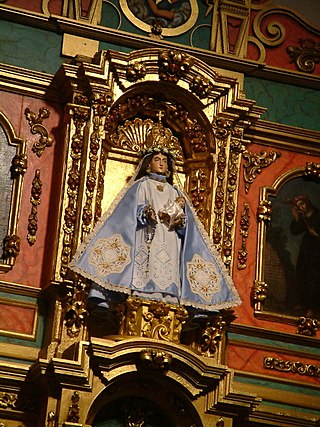
La Conquistadora is a small wooden statue of the Madonna and Child now in the Cathedral Basilica of St. Francis of Assisi in Santa Fe, New Mexico. She was the first Madonna brought to what is now the United States. The statuette is carved out of wood, and measures approximately three feet in height. A Catholic confraternity called, La Cofradía de La Conquistadora, exists to “promote devotion to the Mother of God under the title of La Conquistadora – Our Lady of Peace, and for the upkeep and maintenance of both of her chapels at the Cathedral Basilica of St. Francis of Assisi and the Rosario Chapel”. This confraternity is also responsible for maintaining the icon's chapel located in the north transept of the Basilica. The icon is dressed by the sacristana, or sacristan who maintains the vast wardrobe that includes clothing, veils, crowns, jewels and wigs. Cancer survivors often donate hair for use in fashioning wigs worn by the statue. The garments that the icon is clothed in are often sewn and donated by the faithful; all are rich in detail and very fine, often with elaborate designs. The estimate of her total outfits is close to 300. Even non-Catholics find occasion to honor the statue. For example, actress Ali MacGraw commissioned a piece that was displayed at Santa Fe's Spanish Colonial Museum in an exhibit about the icon mounted during 2010. The statue's origins are not well-known, but the 15th and 17th centuries are the most likely possibilities. Her arrival into America was made possible by the Spanish, who carried several versions of The Virgin Mary with them on their travels. There is a long history of armies carrying statues of saints into battle, for various purposes. Although the exact date of the statue's arrival in the New World is unknown, the Madonna was brought to New Mexico via Mexico City by priest Fray Alonso de Benavides, arriving in Santa Fe on January 25, 1626. Benavides wrote about this date in his journal, but the Archdiocese commonly uses the date of 1625. La Conquistadora was originally known as Our Lady of the Assumption.
De Vargas Center is an enclosed shopping center in Santa Fe, New Mexico named after Diego de Vargas. Originally named De Vargas Mall, the shopping center is one of two enclosed malls in Santa Fe.

A statue of Diego de Vargas made by Donna Quasthoff was installed in 2007 at the west end of Santa Fe, New Mexico's Cathedral Park, in the United States. The statue was removed in June 2020.

Astialakwa was a prehistoric and historic village built by the ancestral Puebloan people located within the Astialakwa Archeological District, in an area now known as the Jemez Springs area of Northern New Mexico. The archeological area is on the National Register of Historic Places. The location is restricted from access.

Lynnette Haozous a Native American painter, printmaker, jeweler, writer, and actor. She is an enrolled member of the San Carlos Apache Tribe and of Chiricahua Apache, Navajo, and Taos Pueblo ancestry. Haozous works in acrylics, watercolors, spray paint, jewelry, screen-printing, writing, and acting on stage and in film. She is known for her murals and uses a blend of art and advocacy to bring attention to social conditions and injustices.
